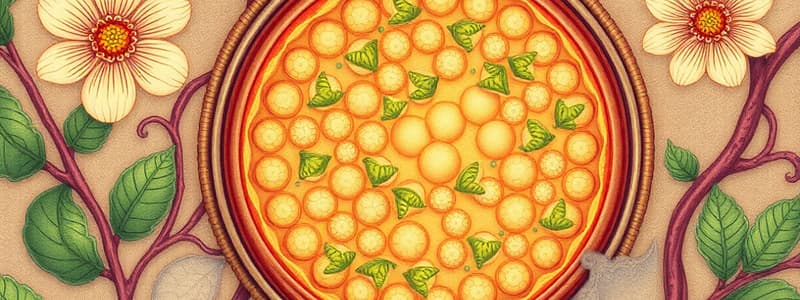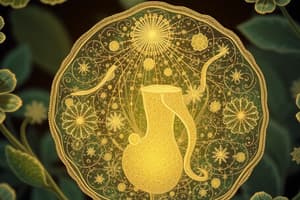Podcast
Questions and Answers
Seeds are only produced by flowering plants.
Seeds are only produced by flowering plants.
False (B)
Which of the following is an adaptation of xerophytes to arid environments?
Which of the following is an adaptation of xerophytes to arid environments?
- Large leaf surface area
- Thick cuticles (correct)
- Floating leaves
- Extensive root systems (correct)
Plants that live in water are called ______.
Plants that live in water are called ______.
hydrophytes
What is the primary function of the endosperm within a seed?
What is the primary function of the endosperm within a seed?
Match the following plant adaptations with their corresponding environment:
Match the following plant adaptations with their corresponding environment:
What is the primary function of the cell wall in plant cells?
What is the primary function of the cell wall in plant cells?
Plant cells are prokaryotic cells, lacking a membrane-bound nucleus.
Plant cells are prokaryotic cells, lacking a membrane-bound nucleus.
What is the name of the process by which plants convert light energy into chemical energy?
What is the name of the process by which plants convert light energy into chemical energy?
The ______ is a large central organelle in plant cells that plays a role in maintaining turgor pressure and storing nutrients.
The ______ is a large central organelle in plant cells that plays a role in maintaining turgor pressure and storing nutrients.
Match the following plant hormones with their primary functions:
Match the following plant hormones with their primary functions:
Which of the following is NOT a type of asexual reproduction in plants?
Which of the following is NOT a type of asexual reproduction in plants?
Plant growth is indeterminate, meaning they cease to grow after reaching a certain size.
Plant growth is indeterminate, meaning they cease to grow after reaching a certain size.
What are the specialized regions of actively dividing cells responsible for plant growth called?
What are the specialized regions of actively dividing cells responsible for plant growth called?
Flashcards
Seed
Seed
The result of fertilization, containing an embryo, endosperm, and seed coat.
Plant Diversity
Plant Diversity
Variety in plant structure, function, and reproduction strategies.
Gymnosperms
Gymnosperms
Seed plants that produce seeds exposed on cones, like conifers.
Xerophytes
Xerophytes
Signup and view all the flashcards
Carnivorous Plants
Carnivorous Plants
Signup and view all the flashcards
Plant Cells
Plant Cells
Signup and view all the flashcards
Cell Wall
Cell Wall
Signup and view all the flashcards
Vacuole
Vacuole
Signup and view all the flashcards
Chloroplasts
Chloroplasts
Signup and view all the flashcards
Photosynthesis
Photosynthesis
Signup and view all the flashcards
Meristems
Meristems
Signup and view all the flashcards
Asexual Reproduction
Asexual Reproduction
Signup and view all the flashcards
Pollination
Pollination
Signup and view all the flashcards
Study Notes
Plant Cell Structure
- Plant cells are eukaryotic cells, possessing a membrane-bound nucleus and other organelles.
- A defining feature is the rigid cell wall composed primarily of cellulose, providing structural support.
- The vacuole, a large central organelle, maintains turgor pressure, contributes to cell growth, and stores nutrients.
- Chloroplasts are unique organelles responsible for photosynthesis, converting light energy into chemical energy.
- Plasmodesmata are cytoplasmic channels connecting adjacent plant cells, facilitating communication and transport.
Photosynthesis
- Photosynthesis is the process converting light energy into chemical energy (glucose).
- Occurs in chloroplasts, specifically the thylakoid membranes where light-dependent reactions occur.
- Plants absorb carbon dioxide from the atmosphere and water from the soil.
- The process involves light-dependent reactions capturing light energy to produce ATP and NADPH, and light-independent reactions (Calvin cycle) using these to convert carbon dioxide into glucose.
- Oxygen is released as a byproduct.
Plant Growth and Development
- Plants exhibit indeterminate growth, continuously growing throughout their lives.
- Meristems are regions of actively dividing cells, responsible for primary (elongation) and secondary (girth) growth.
- Apical meristems are at root and shoot tips, driving lengthening.
- Lateral meristems, like the vascular cambium, increase stem and root width.
- Plant hormones (auxins, gibberellins, cytokinins, abscisic acid) regulate growth and development.
Plant Reproduction
- Plants have diverse reproductive strategies, including asexual and sexual reproduction.
- Asexual reproduction creates genetically identical offspring (runners, tubers, cuttings).
- Sexual reproduction involves gamete fusion (sperm and egg) within flowers, leading to seed formation.
- Flowers are angiosperm reproductive structures, containing male (stamen) and female (pistil) parts.
- Pollination is pollen transfer from anther to stigma, crucial for fertilization.
- Seeds contain the embryo, endosperm (food), and a protective seed coat.
Plant Diversity
- Plants show diverse structures, functions, and reproductive strategies.
- Major groups include non-vascular plants (mosses), vascular plants (ferns), and seed plants.
- Seed plants are divided into gymnosperms (conifers) and angiosperms (flowering plants).
- Adaptations to various environments (water, light, nutrients, temperature) drive plant diversity.
- Plants are essential producers supporting ecosystems and oxygen production.
Plant Adaptations
- Plants have evolved diverse adaptations for survival.
- Xerophytes (arid environments) have thick cuticles, smaller leaves, and water storage tissues.
- Hydrophytes (aquatic environments) have large air spaces for buoyancy and oxygen diffusion.
- Plants in shade have larger leaves for maximum light absorption.
- Carnivorous plants trap insects for nutrients in nutrient-poor soils.
- Plant defenses against herbivores include thorns, spines, chemicals, and toxins.
Studying That Suits You
Use AI to generate personalized quizzes and flashcards to suit your learning preferences.




